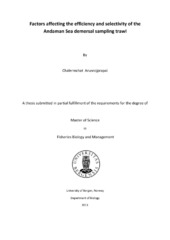| dc.description.abstract | The average catch per unit of swept area (CPUE) from bottom trawl surveys by research vessels are used as an index of abundance for the demersal fish resources of the Thai waters of the Andaman Sea. The surveys are carried out under the assumption of constant swept area and catch efficiency. However, preliminary investigations showed that the geometry varied by depth and based on other studies it is likely that this may affect CPUE. To reduce the variability in trawl geometry by depth, the constrictor rope technique was applied. The length of the rope (6 m) and its position (between the warps; 100 ahead of the trawl doors) were based on trials without rope at the shallowest depth trawled during the routine surveys (20 m). Using the constrictor rope at deeper depths gave similar trawl geometry as obtained at the reference depth of 20 m. When the trawl was fished with the constrictor rope 75 m depth, the mean door distance was reduced by 23% compared to the door distance obtained for hauls without a constrictor rope. Similarly, wing distance was reduced by 18% and the angle of the sweep/bridles was reduced from 20.3 to 15 degrees (26% reduction). The vertical trawl opening was increased marginally (0.12 m; 6.5 %) Despite the difference in trawl geometry, catch rates and catch composition did not differ significantly between the hauls made with and without the constrictor rope. The reason for this is unclear, but it is suggested that the larger area swept when no rope is used is offset by increased escape below the fishing line due to the trawl being overspread. Observations by underwater video cameras in the net mouth area during hauls at shallow depth and without constrictor rope, indicated proper bottom contact of the fishing line. It is therefore suggested that the trawl will have similar bottom contact at all depths when the constrictor rope is used. However, this needs to be verified. Observations of fish showed that fish took up position slightly in front of the fishing line, swimming in the direction of towing. Except for a few rays, no fish were observed to escape below the fishing line. Observations of trawl's fish lock showed that this did not function as intended as fish were observed to swim forward out of the codend during haul back of the trawl. v Sections of gillnet panels mounted to the outside of the top panel of the trawl, showed only marked escape during one haul and only close to the codend. The catch is this haul was approximately an order of magnitude higher than in the remaining hauls, suggesting a density dependent escape. | en_US |
